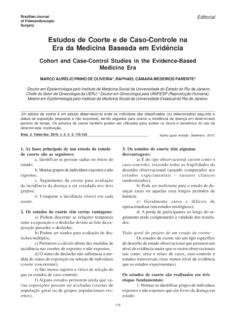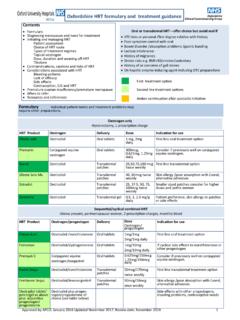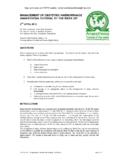Transcription of Fluid Overload after Hysteroscopic Polypectomy - …
1 Yela et J. Video-Sur., April / June 2010 Case ReportBrazilian Journalof VideoendoscopicSurgeryAccepted after revision: December, 04, J. Video-Sur, 2010, v. 3, n. 2: 090-09390 Fluid Overload after Hysteroscopic PolypectomyIntoxica o H drica ap s Polipectomia Histerosc picaDANIELA ANGERAME YELA1, ANA RAQUEL GOVEA2, ILZA MARIA URBANO MONTEIRO3 The study was conducted at the State University of Campinas (Read phonetically Unicamp), Campinas, S oPaulo, Professor, Gynecology Department, Unicamp, Campinas, S o Paulo, Brazil; 2. Surgical Resident, Departmentof Gynecology, Unicamp, Campinas, S o Paulo, Brazil; 3. Full Professor, Gynecology Department, Unicamp,Campinas, S o Paulo, purpose of reporting this case is to show that we must be attentive with any type of Hysteroscopic surgery, since allare subject to complications which can lead to permanent injury and even death.
2 The case described is that of a 72 yearold woman who underwent a diagnostic hysteroscopy for endometrial thickening. During the procedure, the presence ofa fundic endometrial polyp occupying the entire cavity was noted. The patient then underwent surgical hysteroscopy forpolypectomy. Twenty minutes into the procedure, with six liters of glycine infused, the patient developed Fluid Overload andthe procedure was suspended. The patient received Fluid support and electrolyte replacement, and in 48 hours wasdischarged in good condition. This case illustrates a complication of hysteroscopy. Complications of hysteroscopy arerare, especially for Polypectomy with rates of about Complications that can be cited include uterine perforation,infection, hemorrhage, injury to adjacent organs, trauma to the cervix, embolism, and Fluid Overload .
3 Fluid overloadusually occurs with major hysteroscopy surgeries such as myomectomy and endometrial ablation. This type ofcomplication is rare in Hysteroscopic words: Fluid Overload , hysteroscopy, hysteroscopy has an important role inminimally invasive treatment of patients with intra-uterine disease. The main indications for hysteroscopyare the removal of endocervical and endometrial polypsand fibroids, resection of uterine septum, endometrialablation, and lysis of intrauterine adhesions (IUA), aswell as its immense value in the evaluation of abnormaluterine bleeding and surgery has proven safe andhas distinguished itself by the speed with whichpatients return to their regular activities.
4 The literaturehas shown that complications of Hysteroscopic surgeryare infrequent and rarely serious. The main types ofcomplications include uterine perforation, hemorrhage,infection (endometritis), injury to adjacent organs(bladder, intestine), and Fluid Overload from thedistension medium, which has the greatest potentialto become more severe and cause complication associated with distensionmedia, although rare, is serious and can even lead to apatient s death. The main distention media are glycine,sorbitol, mannitol and distilled water. Excessiveabsorption of Fluid and its metabolism can lead to therelease of free water that can set off processes leadingto pulmonary edema, ascites, cerebral edema, andeven One of the ways found to control theamount of liquid absorbed by the patient is theassessment of the difference between the amount ofmedium that is being infused during the procedure andthe amount that is being absorbed.
5 Some authorsdescribe that this deficit should not exceed 1500 ml toavoid Fluid initial clinical symptoms of excessiveabsorption of distension medium are nausea, vomiting,headache, and motor agitation. If not promptly andadequately treated, the patient may develop pulmonaryand cerebral edema and even death. Therefore it isof utmost importance that both the surgical team andthe anesthetic team are constantly communicating, Fluid Overload after Hysteroscopic Polypectomy91 Vol. 3, N 2because if the patient begins to manifest suchsymptoms the procedure should be interruptedimmediately, and appropriate treatment started, andmonitoring of the patient ,6 This presentation of Fluid Overload fromdistention media most commonly occurs inhysteroscopic surgeries such as myomectomy,endometrial ablation and lysis of intrauterine polypectomies, the risk of this type of complicationis very small ( ).
6 2 Nevertheless, we describe acase of a patient who developed a clinical picture offluid Overload during a REPORTThis 72 year old multiparous (G2) whitefemale, whose menopause began 16 years ago, hasbeen taking tamoxifen for four years for a breastadenocarcinoma. In the course of routine follow-upfor the breast cancer, she underwent a pelvicultrasound that revealed endometrial thickening(endometrial lining 17 mm). The patient wasasymptomatic and underwent a our service diagnostic hysteroscopy isperformed without anesthesia, using a 4mm Storzoptic, with the intrauterine cavity distended with carbondioxide gas through the Storz insufflator with pressuresranging from 80 to 100 mmHg.
7 This examination,performed in August 2008, revealed a 1 cmendocervical polyp and a 5 cm fundic pedunculatedendometrial polyp, without alteration of thevascularization on its surface, which completelyoccupied the uterine cavity. An endometrial biopsywas not collected during this laboratory tests were order inanticipation of a surgical hysteroscopy forpolypectomy. While awaiting scheduling of hersurgery, the patient experienced mild vaginal bleedingin February March 2009, the patient underwentsurgical hysteroscopy. During the procedure afundic 5cm pedunculated endometrial polypoccupying the entire uterine cavity was for Polypectomy was performed withthe patient under spinal anesthesia as is standard inour minutes into the procedure, the patientdeveloped vomiting, malaise associated with increasedblood pressure, tachycardia, and motor agitation.
8 Closeto six liters of intrauterine glycine has beenadministered and the vacuum container had about 5liters. The patient, thus, had absorbed one liter ofglycine. The procedure was discontinued after theonset of symptoms. About 80% of the polyp had patient received Fluid support andelectrolyte replacement; her symptoms were treatedwith anti-emetics and hours after the procedure the patientunderwent pelvic ultrasound that revealed a largequantity of free Fluid in the pelvic cavity, andsurrounding the kidney, liver, and spleen. The uteruswas anteversoflexed, measured 76 x 36 x 48mm, andhad an endometrial lining of 10 mm.
9 Tests showed asodium of 134 mEq/L, potassium mEq/L, urea 36mg/dL, and a creatinine of mg/dL; urine outputwas 200 ml. Blood pressure was 140/90 mmHg andheart rate 86 patient was kept fasting, at rest, andreceived replenishment of sodium and furosemide over24 hours. after this period the patient still had mildnausea, but no signs of edema; her blood pressureand heart rate were normal. Laboratory tests showedsodium of 139 mEq/L, potassium mEq/L, urea 17mg/dL, and a creatinine of was discharged 48 hours after theprocedure in good condition, without any electrolytedisturbance or weeks after the procedure, laboratorytests were sodium 141 mEq/L, urea 39 mg/dL,creatinine mg/dL, and a potassium of mEq/L.
10 Pelvic ultrasound revealed a uterus anteversoflexedmeasuring 67 x 35 x 54mm with a volume of 56 mm3and an endometrial lining measuring 17 mm, with nor-mal pathology revealed a polyp in theendometrial mucosa with areas of atrophy and atypicalcomplex hyperplasia. With this finding the patientunderwent total abdominal hysterectomy. Anatomicpathology reported senile cystic atrophy of theendometrial, a Naboth cyst, endometrial hyperplasia,atrophic ovaries and fallopian tubes, and an absenceof of hysteroscopy are relativelyrare events. They usually occur in surgicalhysteroscopies at rates ranging from 3% to 24%.7 Yela et J. Video-Sur.



